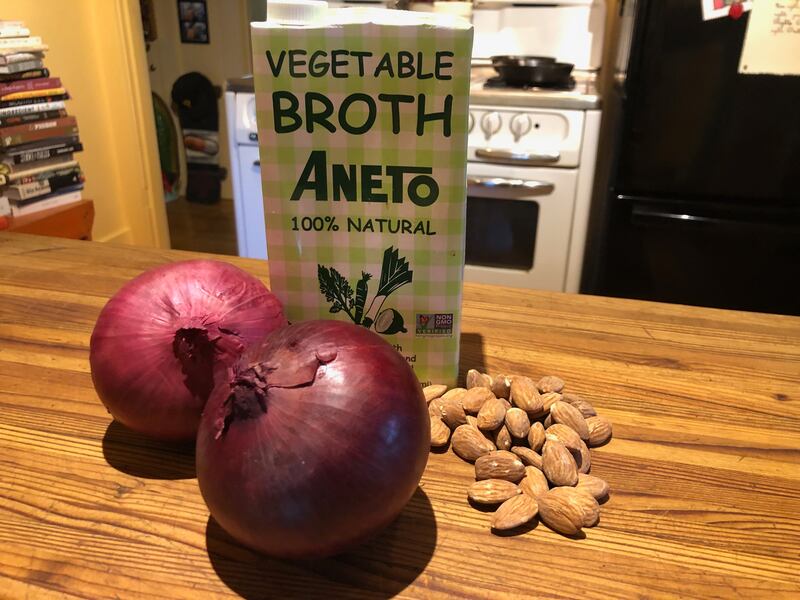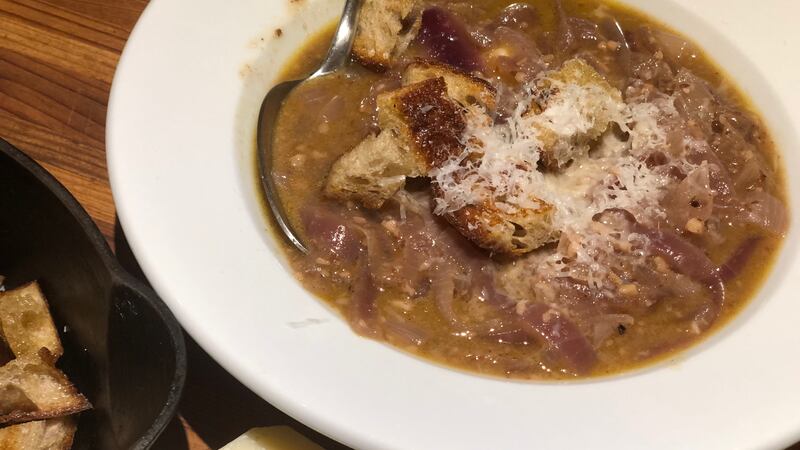Jim Dixon wrote about food for WW for more than 20 years, but these days most of his time is spent at his olive oil-focused specialty food business Wellspent Market. Jim’s always loved to eat, and he encourages his customers to cook by sending them recipes every week through his newsletter. We’re happy to have him back creating some special dishes just for WW readers.
Caterina de’ Medici supposedly loved this soup and thought it was an aphrodisiac, but the oft-repeated story that she introduced it to France, where it evolved into the hearty, beef-flavored potage topped with a thick slice of bread and lots of melty cheese, is a myth. Historians note the very real Italian influence on French cooking predates her reign as queen.
Another famous Italian, Leonardo da Vinci, was also a big fan, according to some accounts. There’s speculation that he was a vegetarian based on his professed love of animals, and most recipes for carabaccia specify using vegetable instead of meat broth. Tuscan versions often call for the locally famous red onions of Certaldo as well.
But even without the historical fun facts, the almond-thickened carabaccia is interesting and, more importantly, delicious. Part of what Italians call cucina povera, the food of the poor, carabaccia is one of the dishes made with a few humble ingredients that transcend the scarcity of the everyman’s pantry. Tuscans grew onions, almonds, and olives for oil, so even the poor contadini could scrape together the ingredients for carabaccia.
While the French put the bread on top, Italians prefer to lay a slice in the bottom of the bowl and pour the soup over it. I’d rather not wrestle with the crusty edges, so I like to cut the bread into cubes, toast it in a skillet with a little more olive oil, than add it to the soup to soften.

Carabaccia, Tuscan Onion Soup
3 large red onions, quartered and sliced about 1/2 inch thick
2 cloves garlic, chopped
2 tablespoons extra-virgin olive oil
1 teaspoon kosher-style sea salt, plus more as needed
1/2 cup almonds, ground to a coarse meal
1/2 teaspoon ground cinnamon
1/2 teaspoon freshly ground black pepper
3-4 cups vegetable broth or water
2 tablespoons wine vinegar
2 tablespoons honey
1 slice of rustic bread per serving
Grated pecorino romano cheese for serving (optional)
If possible, use a wide, deep pan with a lid to help the onions cook more evenly. Or caramelize the onions in a heavy skillet first, then transfer to a stockpot to finish cooking the soup.
Cook the onions in the olive oil with the salt over medium heat, stirring often, until very soft and just beginning to brown—about 20 minutes. Add the garlic and cook for another minute, then stir in the almonds, cinnamon, black pepper, and enough broth to cover everything. Cover, reduce the heat, and simmer for about 45 minutes.
Add the vinegar and honey and cook for another few minutes while you toast the bread.
Cover the bottom of a skillet with a film of olive oil and heat over medium. Cut the bread into bite-sized pieces, add to the oil, and cook, stirring frequently, until the bread is lightly browned.
Ladle the carabaccia into bowls, add some of the bread, drizzle with a little more extra-virgin olive oil, and top with grated Pecorino Romano, if using.
